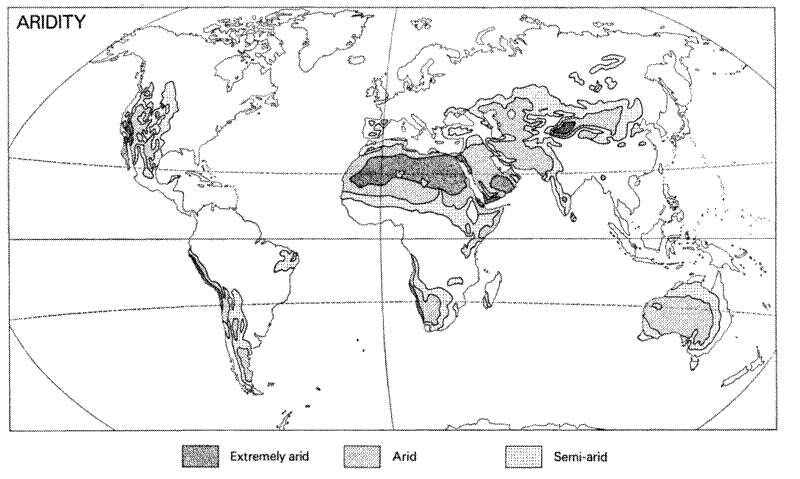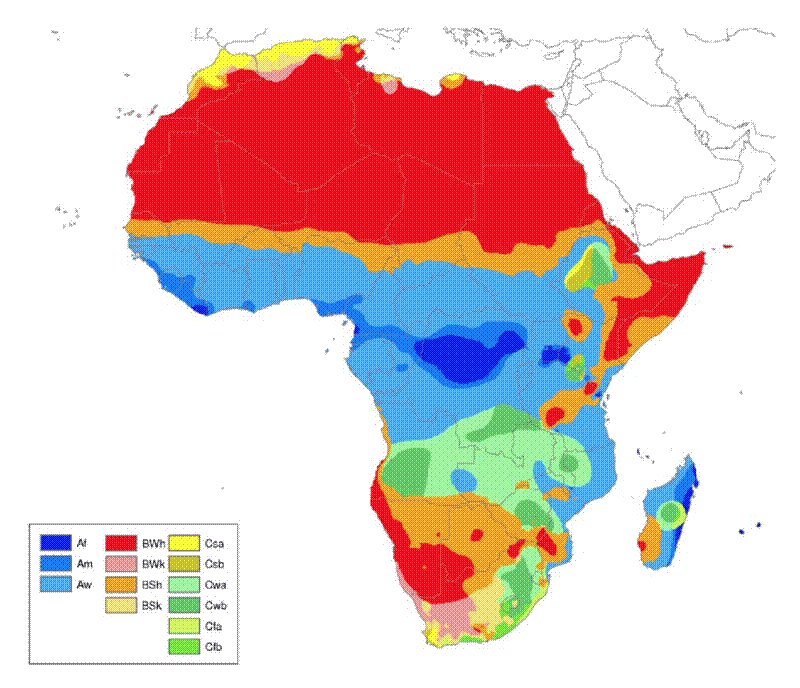I’ve read a few papers that refer to “drylands” and “semi-arid” ecosystems, and I became interested in the definitions of these terms, so here I’ve gathered together some notes on my reading, with the aim of tracing back the definitions through the literature.
Ahlstrom et al. (2015) is a DGVM modelling study that looks at the contribution of different regional terrestrial ecosystem types to the temporal trend and temporal variability of the global land carbon sink. They find that “semi-arid” ecosystems dominate the trend and inter-annual variability of the sink, with these temporal variations being strongly associated with inter-annual variation in precipitation. They define semi-arid ecosystems alongside five other land cover classes: tropical forest, extra-tropical forest, tundra and arctic shrubland, grassland and agriculture, and barren (sparsely vegetated). First they divide into forest, savanna and shrublands, and grasslands and croplands using the MODIS land cover classification (MCD12C1 type 3). They then divide the savanna and shrubland class into two based on latitude. Below 45N they class as semi-arid, and above 45N they class as tundra and arctic shrubland. Below is their map of land cover classes. Tropical forests in light green, extra-tropical forests in dark green, semi-arid in orange, tundra and arctic shrubland in grey, grassland and cops in blue, barren in white.

MacBean et al. (2021) can be seen in a way as a follow up to Ahlstrom et al. (2015). They use the same DGVM model ensemble (TRENDY v7) to evaluate the suitability of these models in modelling carbon dynamics in semi-arid systems. They find that all models under-estimate both the mean annual C uptake/release, as well as the magnitude of NEE IAV, and that the sensitivity and timing of ecosystem C uptake to plant available moisture was the issue, where models under-estimated the response of GPP to water availability during the wet season. MacBean et al. assert that drylands “cover more than 40% of the world surface”. For this statistic they cite Schimel (2010).
Schimel (2010) actually says that drylands cover about 45% of the Earth’s land surface, but they don’t cite this statistic or show their working. Schimel (2010) is itself a cover piece for Rotenberg and Yakir (2010), which appears in the same issue of Science, so I guess they are implicitly referencing that article.
Rotenberg and Yakir (2010) quote that semi-arid regions cover 2.4 billion ha, ~17.7% of total land surface area, and for this statistic they cite (Lal 2004). Rotenberg and Yakir (2010) is a study of one particular semi-arid pine forest in southern Israel called Yatir, whee there is a flux tower. They measured fluxes of CO2, water vapour and photosynthetic activity.
Lal (2004) defines drylands as regions in which the ratio of total annual precipitation (P) to potential evapotranspiration (PET) (Aridity Index, P:PET), ranges from 0.05 to 0.65. They say these regions cover 6.15 billion ha, 47.2% of earth’s land area. Lal (2004) is sort of a review article on the importance of dryland ecosystems in the carbon cycle.
The aridity index values and classifications quoted in Lal (2004) come from UNEP (Middleton and Thomas 1997), the World Atlas of Desertification, 2nd edition, specifically pages 5-7. In this they define multiple aridity zones bounded by the Aridity Index P:PET:
- Humid >0.65
- Dry sub-humid 0.5-0.65
- Semi-arid 0.2-0.5
- Arid 0.05-0.2
- Hyper-arid <0.05
In this chapter, Middleton and Thomas say that their classification comes fom an earlier iteration used in the UNSECO (1977) map of aridity. The boundaries between arid and hyper-arid zones, and dry sub-humid and humid zones were changed for the 1997 map, after they found that PET was being under- and over-estimated in very dry and moist climates, respectively. They also introduced a separate cold and mountains zone, acknowledging that while these areas may be arid, they present a different range of environmental issues than warm dryland environments.
Heathcote (1983), in The Arid Lands: Their Use and Abuse, observes that the UNSECO (1977) map is very similar to the map of Meigs (1953), which was also prepared for UNESCO for their extended project on drylands, which ran between 1951 and 1964. The maps in Meigs (1953) use a different aridity index to UNESCO (1977). Meigs uses the Thornthwaite (1948) climate classification, which uses an aridity index of 100(d/n), where d is the sum of monthly differences between P and PET for those months when the average precipitation is less than the average evapotranspiration, and n is the sum of monthly values of PET for the deficient months. Grove et al. (1977) shows that Meigs’ definition of extremely arid lands aligns well with areas receiving less than 25 mm annual rainfall or at least 12 consecutive months without rainfall, arid as 25-200 mm, semi-arid as 200-500 mm.

The Köppen-Geiger climate classification (Köppen 1884, Peel et al. 2007) uses a mixture of temperature and precipitation thresholds to define arid areas, as well as tropical, temperate, cold and polar, with subgroups. Ahlstrom et al. (2015) reference the Köppen-Geiger classification in their classification of tropical and extra-tropical forests, but they don’t use it to classify semi-arid regions. In the Köppen-Geiger classification, arid areas are defined as areas where mean annual precipitation (MAP) is less than 10x a key precipitation threshold. The precipitation threshold is 2x mean annual temperature (MAT) if 70% or more of MAP occurs in the cooler six months of the year, 2xMAT+28 if 70% or more of MAP occurs in the warmer six months of the year, or otherwise 2xMAT+14.

The FAO defines arid zones as those areas where the length of the growing period is less than 180 days (FAO 2000); this includes regions classified climatically as arid, semi-arid and dry sub-humid (from Gaur 2018).
The Holdridge life zones (Holdrige 1947, 1967), determine semi-arid regions as having an aridity index P:PET value less than approximately 0.5.

Other definitions in the literature
Here I am compiling a list opportunistically of other definitions of drylands and semi-arid ecosystems, as I encounter them in the literature.
Kindt (2023) - “Dryland locations were defined by a CMI < -0.35”, where CMI is the Climatic Moisture Index, aka the aridity index P:PET as used by Middleton and Thomas (1997).
Wang et al. (2022) - “Drylands are commonly defined as regions where precipitation is substantially smaller than atmospheric water demand (as quantified by potential evapotranspiration, PET). They are the largest biome on Earth (Schimel 2010), covering about 40% of the terrestrial land surface”